The avian realm is such an enchanting part of the animal kingdom, filled with amazing and mesmerizing feathered creatures. From joyful jacanas to jubilant juncos, each bird species has its own fun personality and distinctive features that set them apart from the rest. Let’s take a look at 20 of these dazzling birds that start with J!
1. Jacamar (Galbulidae)
Many people think that jacamars look a lot like hummingbirds, but believe it or not they’re actually related to puffbirds and toucans! These dazzling birds are between 5 to 13.5 inches long and weigh up to 2.65 ounces. They are beautifully colored birds with slim bodies and glittering, iridescent feathers. They have short legs that are not particularly strong and mainly eat insects with their long, thin beaks. Jacamars live in tropical areas of South and Central America.
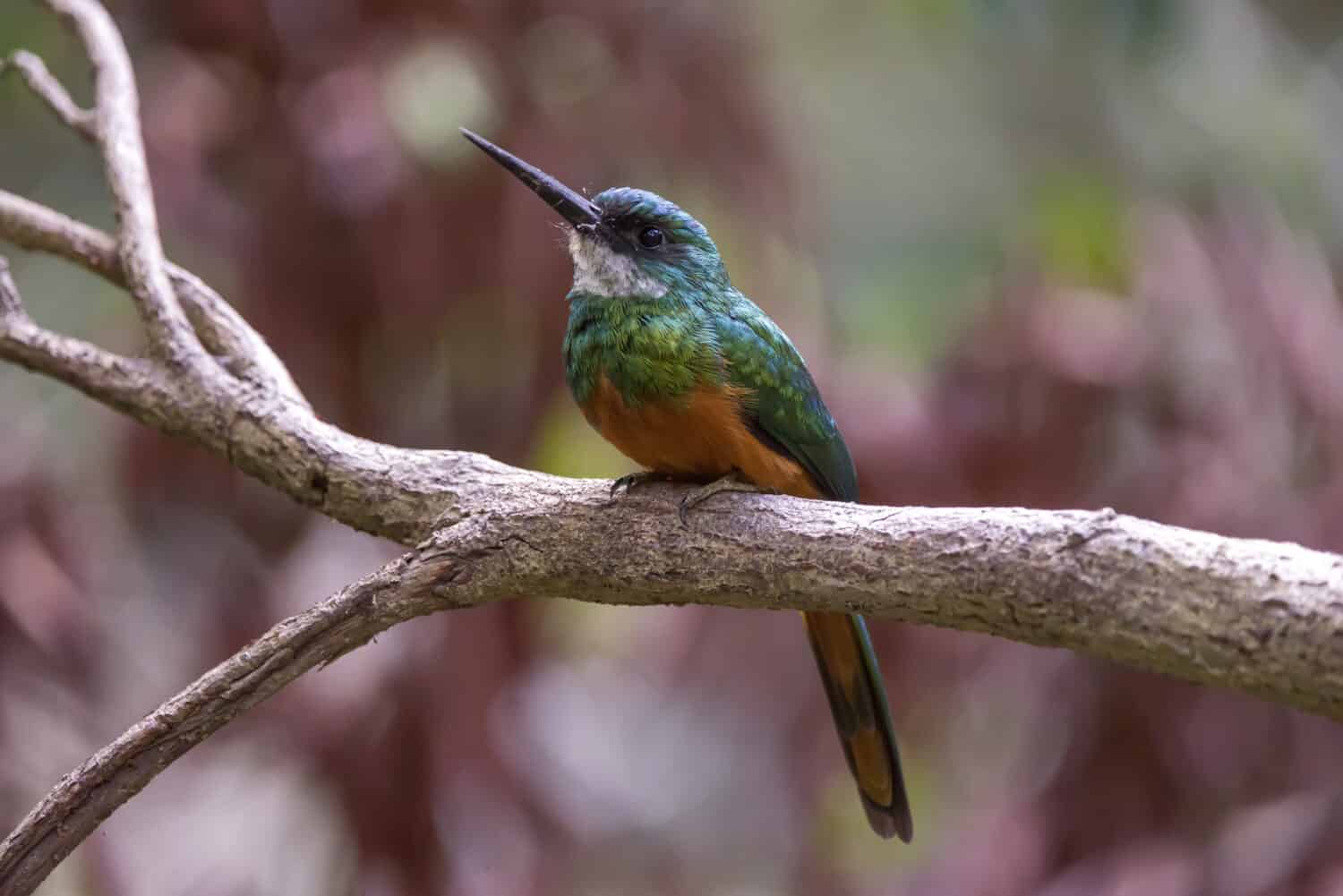
Jacamars capture insects while flying through the air.
©Leonardo Mercon/Shutterstock.com
2. Jackdaw (Coloeus)
Another unique bird that starts with J is the jackdaw, a beautiful, dark-colored bird that is closely related to the raven and crow. You’ll notice their blackish crown, tail, and wings, which give them quite a sharp and dapper appearance. However, unlike crows and ravens, the rest of their feathers are much lighter, almost as if they were wearing a fancy suit jacket with a nice white shirt underneath. Jackdaws live in Western Asia, North Africa, and Europe. There are two types of jackdaw birds: the western jackdaw (Coloeus monedula) and the Daurian jackdaw (Coloeus dauuricus). The two look very similar, but the Daurian jackdaw is slightly smaller, and its pale-colored feathers are almost white.

Jackdaws may look like crows and ravens, but they are actually a bit smaller.
©Tom Meaker/Shutterstock.com
3. Jacana (Jacanidae)
These dazzling birds that start with J are very unique and colorful water birds that live in Australia, Africa, Asia, and the Americas. Jacanas have very long legs and unusually long toes and claws that help them to spread their weight over a larger area. This allows them to walk across vegetation floating on the surface of the water. In fact, since they can walk across lily pads with ease, they are sometimes called lily trotters. Others even refer to them as Jesus birds because they seem to walk on water! They are also really good swimmers and can stay underwater for quite a while. When they feel threatened, jacanas will hide below the surface, with just the very tip of their bills above water for air.

There are several different species of jacanas that live in the floating vegetation in lagoons and marshes.
©Ondrej Prosicky/Shutterstock.com
4. Jacobin Pigeon (Columba livia)
The Jacobin pigeon is certainly not your average bird. These unique show birds have a muff or cowl of feathers that create an impressive rosette on both sides of their heads. It consists of a mane on the back of the head, a hood on top, and a cravat of two lines of feathers running down the front of the bird’s chest. Jacobin pigeons get their name from the Jacobin monks who lived in France in the 1100s. The monks wore very distinctive hoods, much like the feathery hood of the Jacobin pigeon.

Jacobin pigeons are descended from rock pigeons in Asia.
©Eric Isselee/Shutterstock.com
5. Jabiru (Jabiru mycteria)
The jabiru is a massive stork that is mostly white, although its head and upper neck are black and don’t have any feathers. In addition, there is a bright red pouch at the bottom of the bird’s neck that can stretch out super far. This neck pouch helps the jabiru when it comes to dinner time. It allows the bird to scoop up large amounts of water and then filter out the fish to eat. The jabiru is super tall — it’s actually the tallest flying bird in Central and South America! This dazzling bird that starts with J also has an incredible wingspan — in fact, the only other bird in Central and South America with a larger wingspan is the Andean condor.
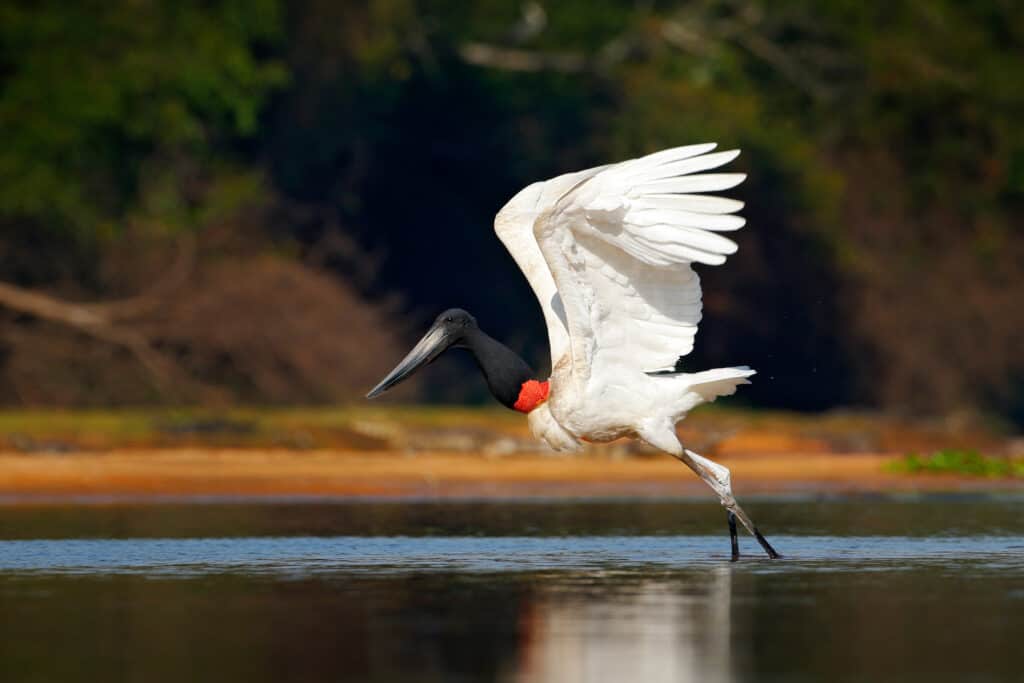
“Jabiru” means “swollen neck” in a Tupi-Guaraní language.
©Ondrej Prosicky/Shutterstock.com
6. Jungle Babbler (Argya striata)
These social birds like to forage together in groups of six to 10, which is how they earned the nicknames “Seven Sisters” and “Seven Brothers” in northern India and Bengali. Jungle babblers live in the Indian Subcontinent and do not migrate. They are not very strong fliers and have short, rounded wings. Both male and female jungle babblers look the same, with brownish-gray feathers of various shades and small, yellow bills. Like their name, jungle babblers are quite noisy birds, and sometimes you can hear them from far away as they noisily chatter and chirp to one another.

Jungle babblers prefer habitats in forests and cultivated areas.
©Faisal Awan/Shutterstock.com
7. Junco (Junco)
Juncos live in North America where they like to hang out in dry soil and make their home on the edges of forests. You can find these cute little birds all over North America, from as far north as the subarctic taiga to as far south as Panama. Juncos like to search for their food on the ground, and during the winter they travel together in large groups. Their diet consists mostly of bugs and seeds. Juncos are small birds that are usually grayish in color, and they have cute little rounded bodies.
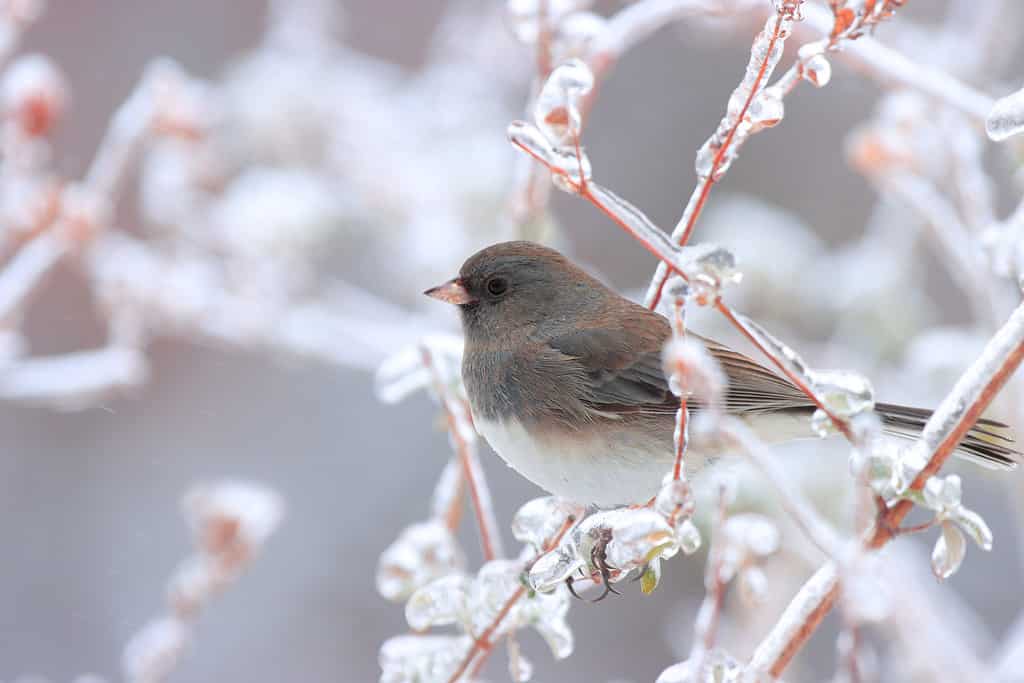
Even though the genus
“Junco”refers to rushes, juncos actually prefer living in areas of dry soil.
©Walter Coate/Shutterstock.com
8. Java Sparrow (Padda oryzivora)
These small and striking little birds measure between 5.9 and 6.7 inches and are about the same size as a house sparrow. Java sparrows have a grayish-brown back and chest, with a lovely pink belly. Their sweet little faces are quite distinct, with a jet black head, white cheeks, and a bright red ring surrounding their eyes. They also have cute pink feet and a striking fuchsia red bill. Java sparrows live in Java, Bali, and Bawean in Indonesia. They have been introduced in a few other places, such as on Oahu and a few other Hawaiian islands in the United States. Unfortunately, these beautiful little birds are endangered and are extremely threatened by the illegal exotic pet trade.

Java sparrows have been kept as pets in Asia since the seventeenth century.
©iStock.com/Oscar Gutierrez Zozulia
9. Jaeger (Stercorarius parasiticus)
These dazzling birds that start with J travel quite a bit, migrating to places like northern Scandinavia, Iceland, Greenland, Scotland, northern Canada, Siberia, and Alaska to breed. Jaegers are medium-sized birds, measuring about 16 to 19 inches long. These frequent flyers make some really interesting sounds like a nasally cat. In the summer they eat small birds, eggs, insects, and rodents. However, during the rest of the year, they are actually kleptoparasitic, which means that they steal food from other birds! Unfortunately, jaegers are endangered, especially in Iceland.
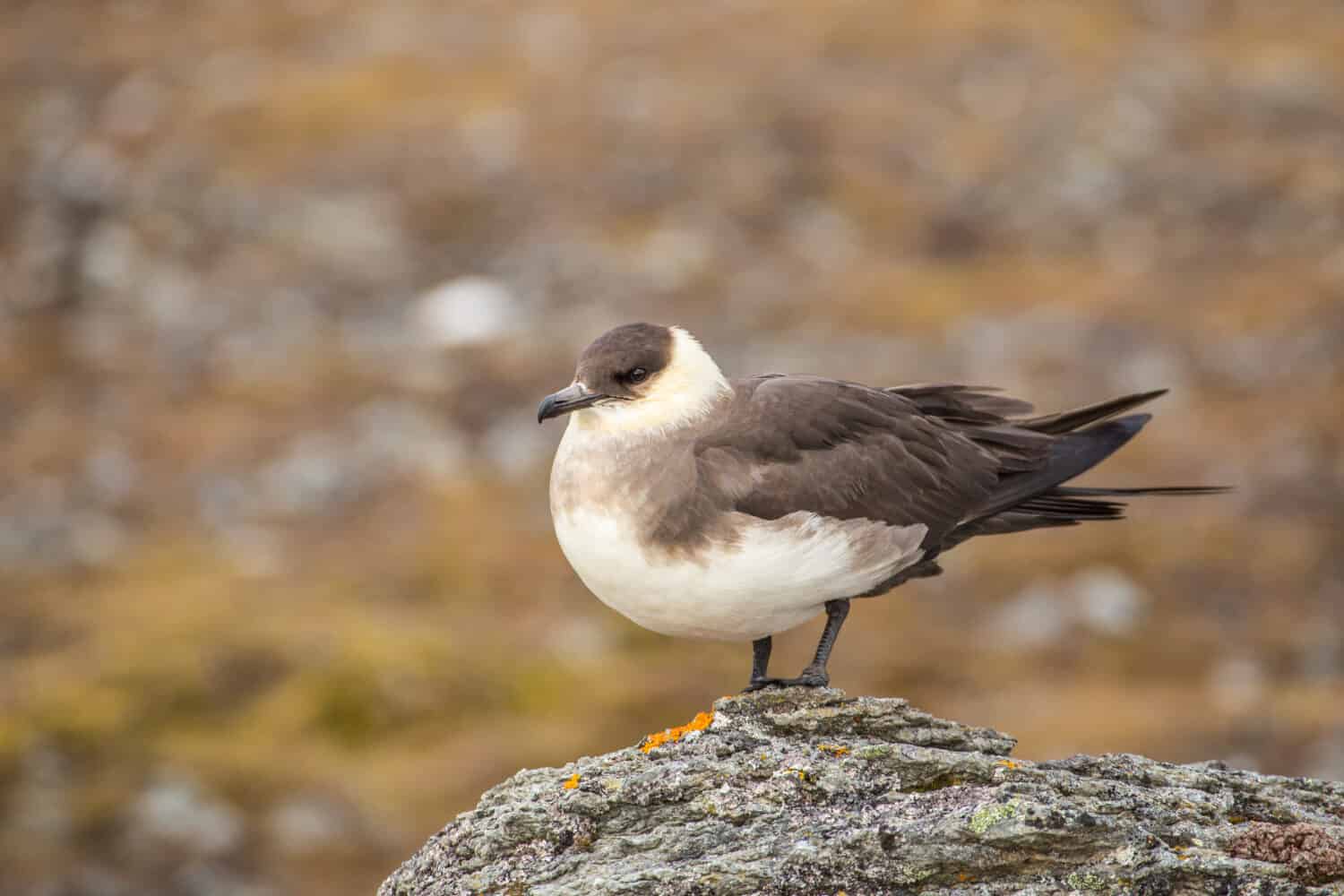
Jaegers come in three different color morphs.
©Kris Grabiec/Shutterstock.com
10. Jack Snipe (Lymnocryptes minimus)
A type of wader or shorebird, the Jack snipe is the smallest type of snipe out there. These petite little birds usually only measure between 7.1 and 9.8 inches long, with a wingspan of 12 to 16 inches. However, in spite of their small size, they’re also pretty stocky and strong. Jack Snipes have mottled brown feathers covering their backs and wings, while their bellies are lighter or paler in color. One of their most distinctive features is a dark stripe that runs through their eyes. When Jack snipes take off in flight, they reveal bright yellow stripes on their backs that are quite eye-catching.

The Jack snipe is the smallest type of snipe.
©Elipsix/Shutterstock.com
11. Jungle Myna (Acridotheres fuscus)
A member of the starling family, the jungle myna is found all over India except for in the super dry regions. You can tell it apart from other similar birds because it has a unique poof of feathers on its forehead like a little mohawk. The bird’s eyes are either pale yellow or blue depending on where it lives, and its bill is orange-yellow with a dark base. The jungle myna is about 9 inches long and has gray feathers, with darker colors around its head and wings. Male and female birds look the same, and they have big white patches on their wings that gradually turn white toward their wingtips.
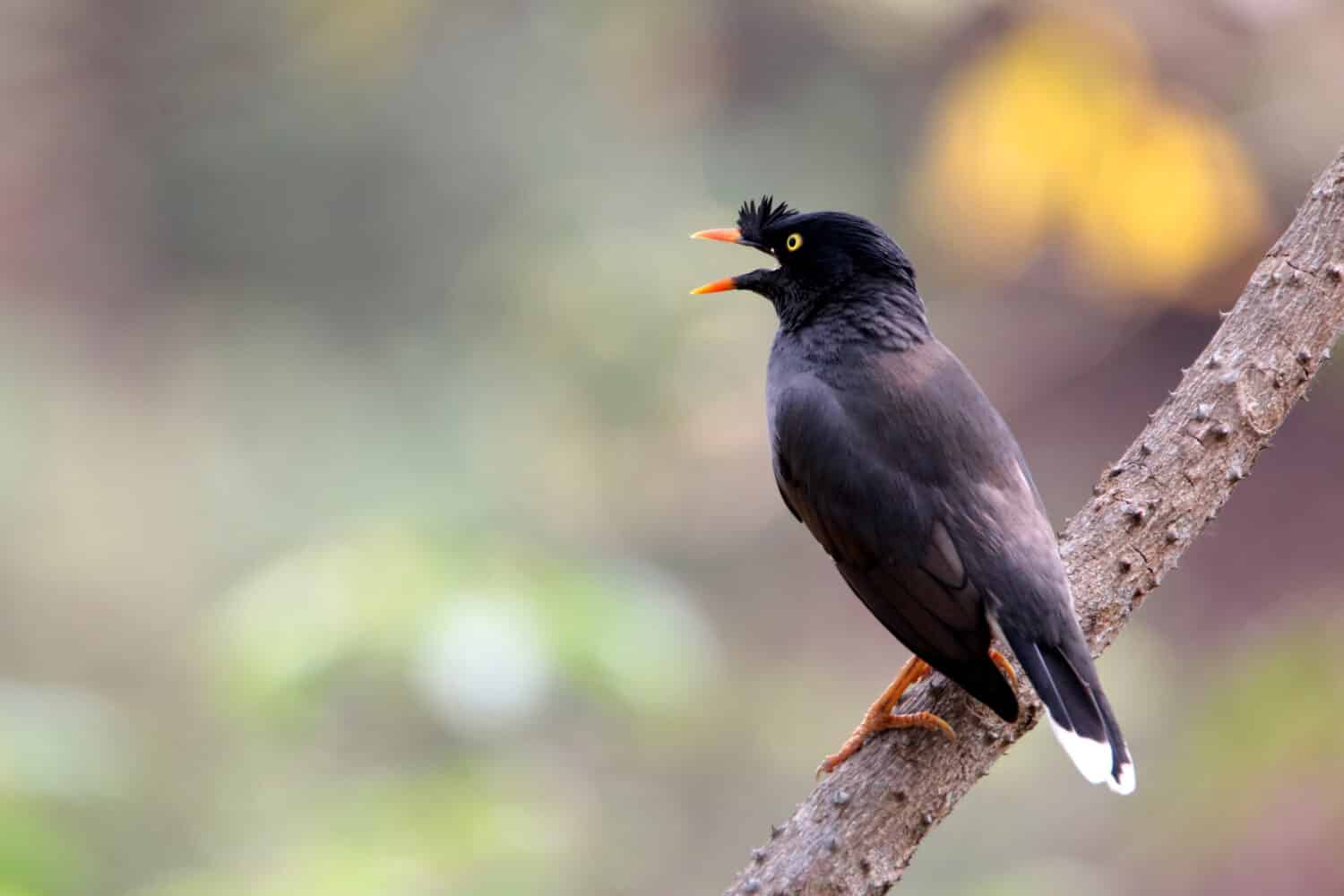
Jungle mynas are omnivores and mainly eat insects, seeds, and fruits.
©EMILY19/Shutterstock.com
12. Jackson’s Hornbill (Tockus Jacksoni)
These medium-sized birds that start with J can be found living in the dry savannahs of Northwest Kenya and Northeast Uganda. Jackson’s hornbills are striking black and white birds that flock together in large groups to survive in their harsh environment. The bodies of male and female birds look very similar, but their bills easily distinguish them. Male birds have a yellow or white tip on their mostly red bills, while females have all-black bills. Jackson’s hornbills are quite social and like to live in pairs or small groups. These resourceful birds are omnivores and enjoy anything from juicy fruits to crunchy insects and even small animals.

Female Jackson’s hornbills have black bills, while males have red beaks.
©Maslowski Marcin/Shutterstock.com
13. Javan Hawk-Eagle (Nisaetus bartelsi)
One of the rarest raptors in the world is the Javan hawk-eagle. It can only be found in Indonesia, where it also happens to be the national bird. Locals even call it Garuda — the name of a Hindu demigod who is known as the king of all birds. These massive and majestic birds are almost 2 feet long, with reddish-brown heads and necks that are heavily barred with black feathers underneath. Their back and wings are dark brown, and their most iconic feature is the long black crest of feathers tipped in white standing atop the bird’s head. Unfortunately, the stunning Javan hawk-eagle is an endangered species.

The Javan hawk-eagle is the national bird of Indonesia.
©1346291609/Shutterstock.com
14. Jacky Winter (Microeca fascinans)
This cute bird can be found all over Australia and Papua New Guinea. It likes to hang out in farmlands and open woodlands, and during the day it sits up high in the trees or on top of poles. Jacky winters spend much of the day cleaning their feathers and basking in the sun. Their name comes from the strong and speedy noise they make, which sounds like “Jacky-Jacky Winter-Winter”. You can hear them making these unique sounds before the sun comes up, but they usually stop by the middle of the day. On occasion, they’ll start back up again near sunset.
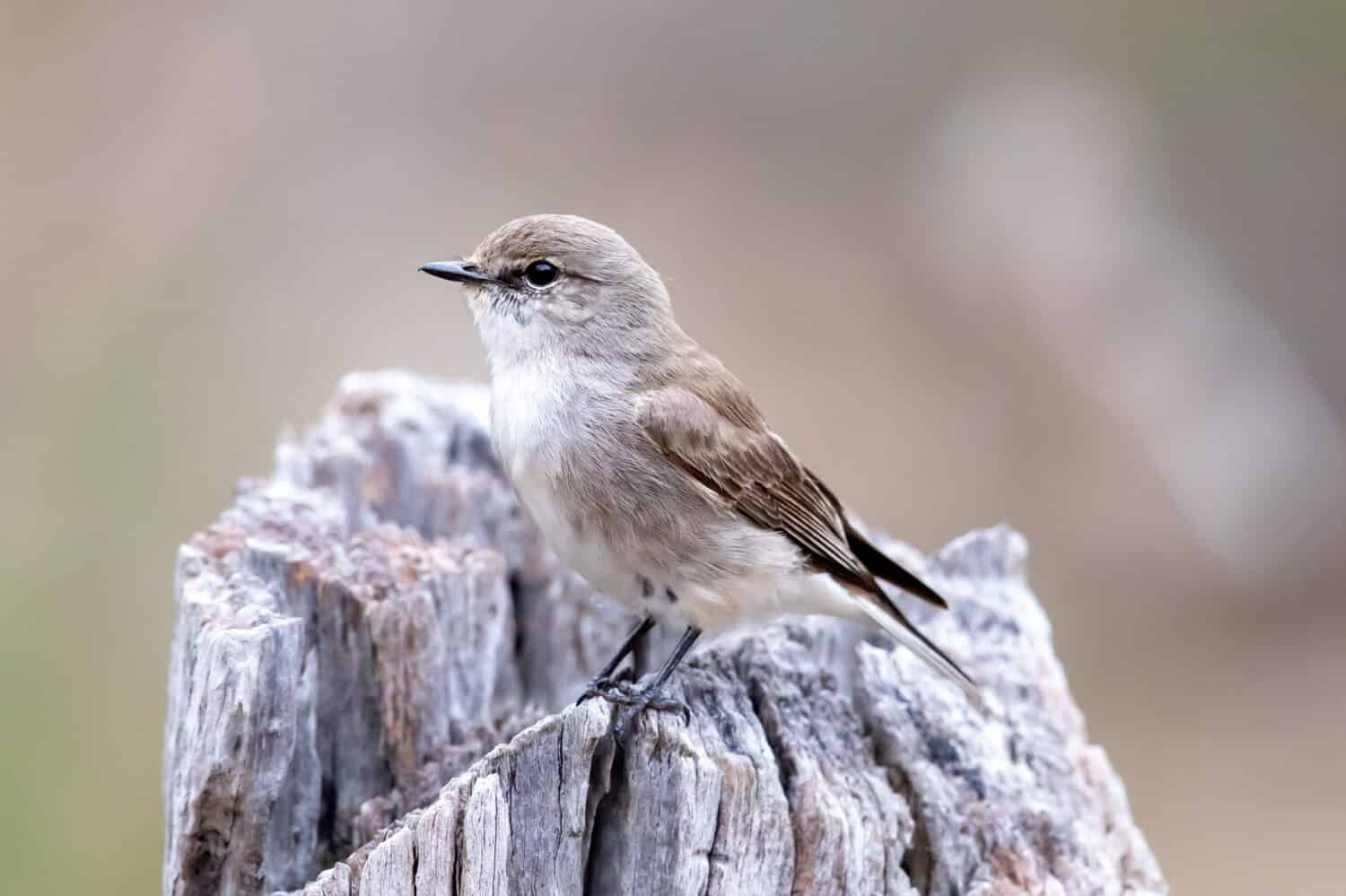
Jacky winters are insectivores.
©Imogen Warren/Shutterstock.com
15. Jackal Buzzard (Buteo rufofuscus)
One of the largest buteo species (hawks) on the planet is the jackal buzzard, which can grow up to 2 feet in length with a wingspan that is over 4 feet across. This massive bird of prey lives all over South Africa, except for some regions in the north. Not only is the jackal buzzard enormous, but it is also quite stunning. Its feathers are almost all black on top, but it has a reddish-brown chin and throat. The rest of the bird’s body is also a rich reddish-brown, with black and white markings on its belly.
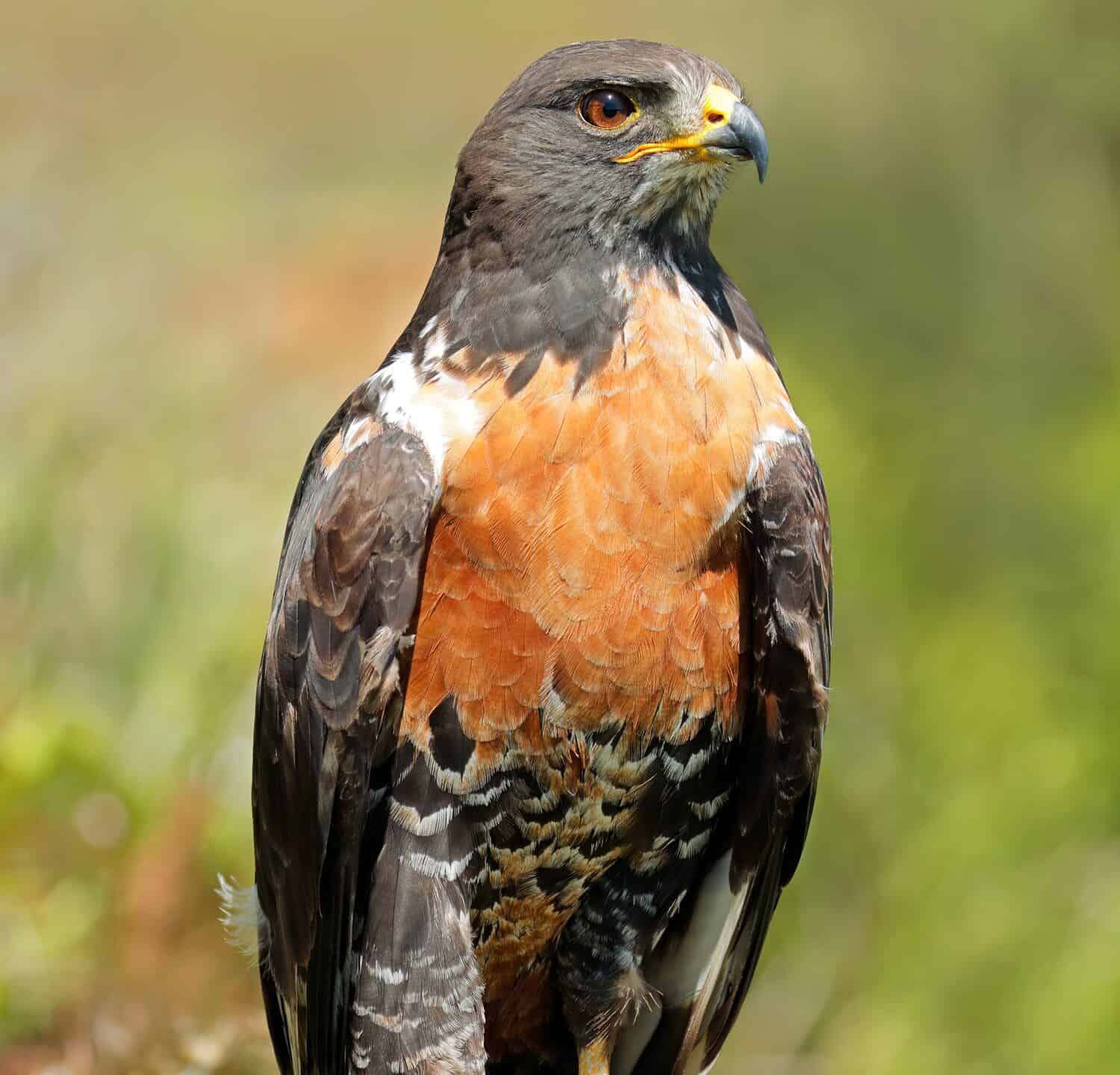
Jackal buzzards live in mountains and open grasslands, but they can live in many different habitats.
©EcoPrint/Shutterstock.com
16. Joyful Greenbul (Chlorocichla laetissima)
These dazzling birds that start with J love to sing their little hearts out in the forests of East-Central Africa. Joyful greenbuls are medium-sized birds around 7.9 inches long. These cheery songbirds sport a bright yellow-olive upper body and a beautiful yellow underbelly, with very distinct reddish-brown eyes. Their name comes from the happy and cheerful songs that they sing. Joyful greenbuls eat fruits, nectar, and insects.

Joyful greenbuls typically live together in groups in humid forests.
©Francesco Veronesi / CC BY-SA 2.0 – License
17. Jacobin Cuckoo (Clamator jacobinus)
The Jacobin cuckoo can be found in Africa and Asia, but it doesn’t stay in one place all year round. Instead, it partially migrates depending on the season. In India, people have noticed that this bird tends to arrive around the same time as the monsoon rains. In addition, the Jacobin cuckoo is often connected to a bird from Indian mythology and poetry called chātaka. According to legend, the chātaka is special because it has a beak on its head and waits for the rain to come so it can quench its thirst. Just like the chātaka, the Jacobin cuckoo also seems to arrive right before it’s time for some massive rainstorms.

Some people consider Jacobin cuckoos to be natural weather forecasters.
©ThulungPhoto.com/Shutterstock.com
18. Javan Kingfisher (Halcyon cyanoventris)
Endemic to the Indonesian islands of Java and Bali, the Javan kingfisher is known for its incredibly striking colors. This dazzling bird has a rich purple body, vivid turquoise feathers on its wings and tail, a large, red bill, and dark red feet. Despite its name, the Javan kingfisher isn’t as well suited for aquatic hunting like many of its relatives. Instead, this bird catches most of its prey on land or near the water’s edge. In addition, the Javan kingfisher lives in a variety of habitats and doesn’t always need to be close to a body of water.
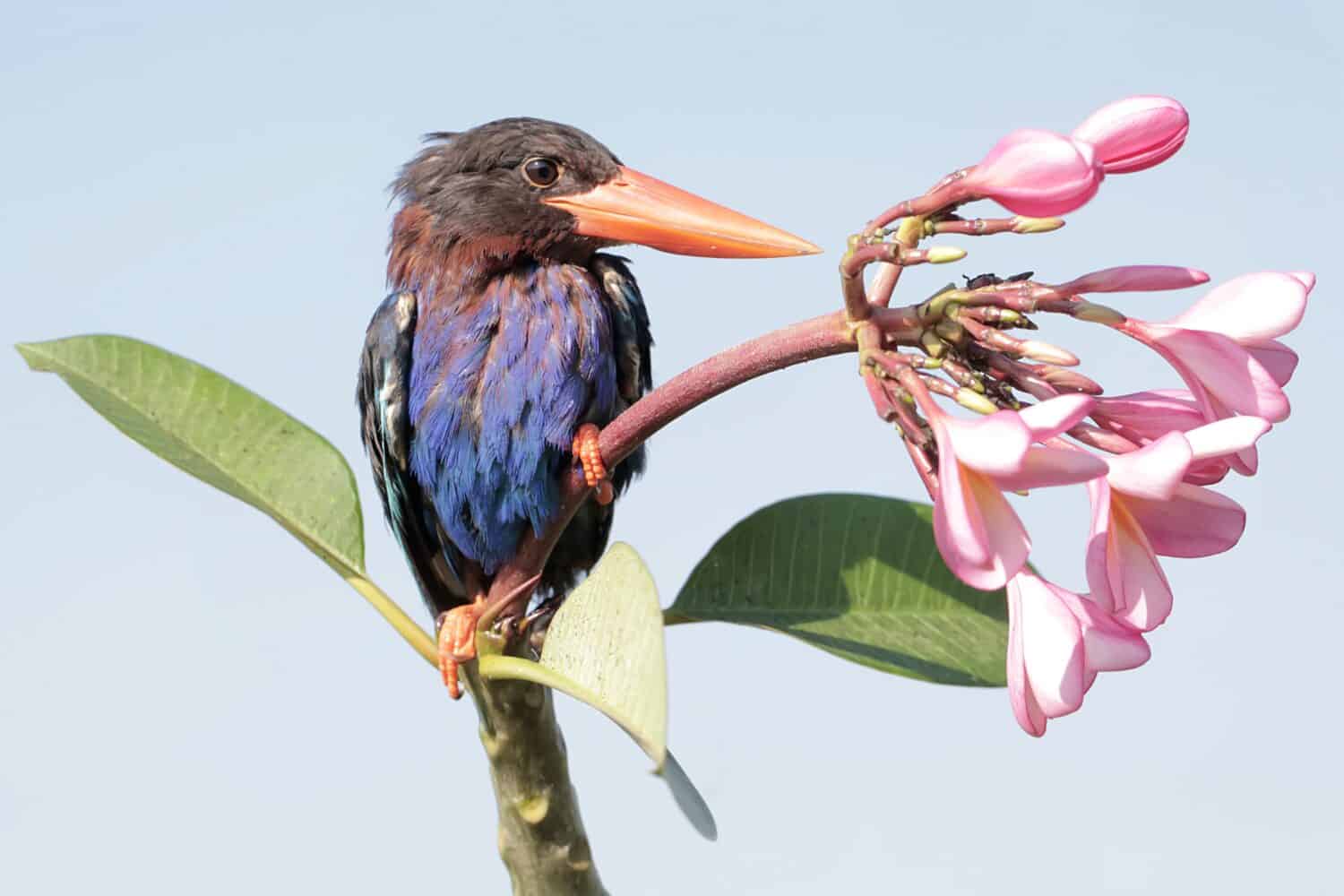
Javan kingfishers grow 9.8 to 10.6 inches long.
©I Wayan Sumatika/Shutterstock.com
19. Japanese Robin (Larvivora akahige)
These adorable little birds live in Japan, all the way from the south of the Kuril and Sakhalin Islands to the main islands. They are migratory birds and they love to spend winters in southeast Asia. Japanese robins are quite small, only about 5.91 inches long, but they stand out with their gray and bright orange feathers. Male birds have an olive-brown color from the top of their heads down to their rumps, with an orange face and neck and a black bill. Females look very similar but their orange and brown colors are not quite as bright.

Although they are shy birds, Japanese robins love to sing.
©Matthewshutter/Shutterstock.com
20. Jandaya Parakeet (Aratinga jandaya)
The Jandaya parakeet, or Jenday conure, is a small and vibrantly parrot that comes from wooded areas in northeastern Brazil. Measuring only about 12 inches long, this pint-sized parrot boasts a reddish-orange body with a yellow head, neck, and shoulders, and a green tail, vent, and wings. In addition to its beautiful appearance, what really sets the Jandaya parakeet apart is its loud and shrill call. In the wild, these birds congregate and enjoy snacking on fruits like mango and cashew apples, as well as plants cultivated by humans.
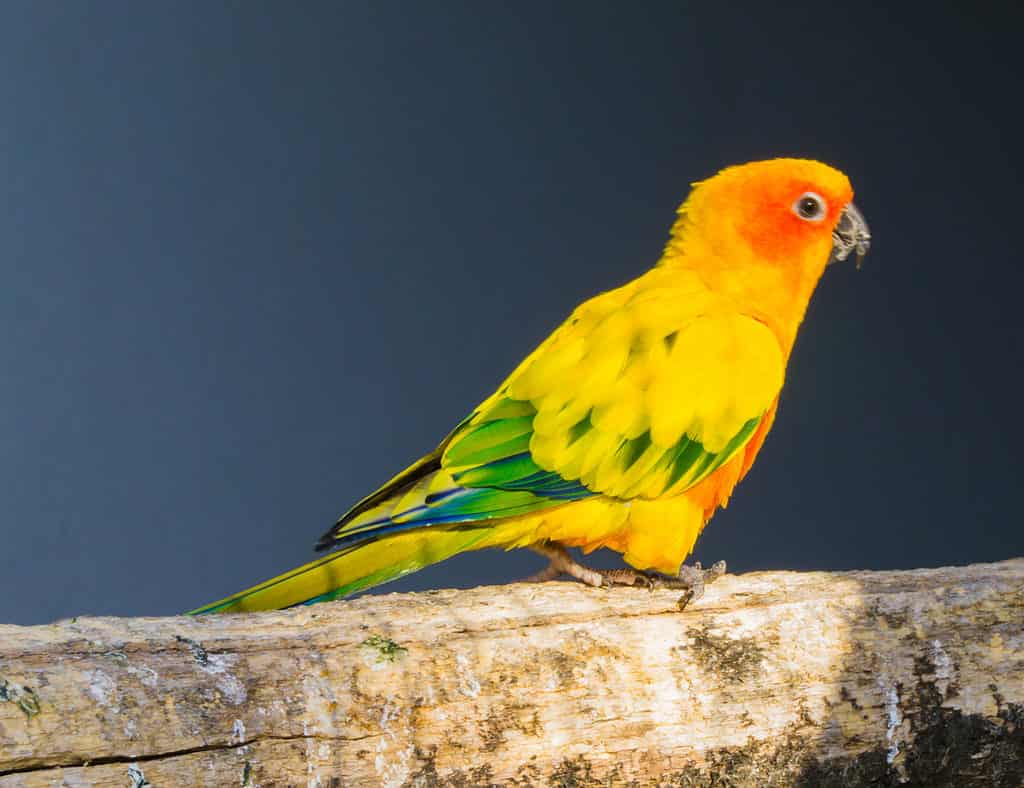
Although they are pretty rare in the wild, Jandaya parakeets are popular as pets due to their social nature.
©iStock.com/Charlotte Bleijenberg
Summary of Dazzling Birds That Start With J
| Common Name | Scientific Name |
|---|---|
| Jacamar | Galbulidae Family |
| Jackdaw | Coloeus Genus |
| Jacana | Jacanidae Family |
| Jacobin Pigeon | Columba livia |
| Jabiru | Jabiru mycteria |
| Jungle Babbler | Argya striata |
| Junco | Junco Genus |
| Java Sparrow | Padda oryzivora |
| Jaeger | Stercorarius parasiticus |
| Jack Snipe | Lymnocryptes minimus |
| Jungle Myna | Acridotheres fuscus |
| Jackson’s Hornbill | Tockus Jacksoni |
| Javan Hawk-Eagle | Nisaetus bartelsi |
| Jacky Winter | Microeca fascinans |
| Jackal Buzzard | Buteo rufofuscus |
| Joyful Greenbul | Chlorocichla laetissima |
| Jacobin Cuckoo | Clamator jacobinus |
| Javan Kingfisher | Halcyon cyanoventris |
| Japanese Robin | Larvivora akahige |
| Jandaya Parakeet | Aratinga jandaya |
The photo featured at the top of this post is © Ondrej Prosicky/Shutterstock.com
Thank you for reading! Have some feedback for us? Contact the AZ Animals editorial team.







